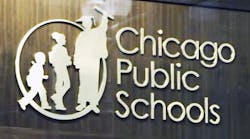Like a precision machine, a school cleaning program that operates at maximum efficiency and with minimal problems is a product of careful design. Ideally, a good program would use no inefficient tools, perform no redundant tasks and expend no unnecessary energy. This can only happen, though, through proper planning and follow-through.
A smart team-cleaning program is first created on paper, based on a building analysis. From this blueprint or schematic, the components of team cleaning-workers, tools, skills, schedules, job-card assignments and building areas or quadrants-are made to precisely mesh and coordinate, producing clean, healthy buildings at the lowest expenditure of time, energy and other resources.
Ultimate efficiency
Team cleaning deploys an "assembly line" of workers to clean in a manner that is fast, focused, duplicable and largely free from quality-control problems. The difference is, rather than the product moving down an assembly line, the labor moves.
Cleaning tasks typically are grouped into four distinct functions:
-Light-duty-Dusting, emptying trash, spot cleaning, etc.
-Vacuum-Vacuuming carpets and hard floors.
-Restroom-Cleaning, sanitizing and restocking restrooms.
-Utility-Cleaning glass, mopping and scrubbing floors, etc.
Team cleaning allows flexibility in staffing levels and in the size and complexity of the facility to which it is applied. One person can complete all steps of the team-cleaning process by performing each function in prescribed sequence, and can do so more quickly than in older systems, such as zone cleaning. In complex environments, teams may consist of up to seven workers. Most often, teams consist of between one and four workers who individually or collectively complete the four primary functions in a precise sequence that optimizes quality and speed.
Defining responsibility
In team cleaning, each of the four functions on the "production line" is well-defined. By design, the team system is a simple approach to cleaning. Training is straightforward and easy to understand, with few cleaning tasks to learn and perform. By focusing primarily on one type of work (while cross-training and rotating for flexibility), each team member becomes more skilled, more effective and more knowledgeable about safe, sound procedures for that job. Examples of job functions include:
-Light-duty. Empty trash and reinstall liners; dust all horizontal and vertical surfaces. Pick up paper clips, paper and pencils from floor; spot-clean door glass. Position trash in a strategic location for the utility specialist to pick up and take to the dumpster. Lay a clean liner down before placing a full trash liner on the floor. Lay the trash container on its side, and slowly remove the full liner. The above steps will prevent unnecessary spots and spills on floors, while preventing back stress.
-Vacuum. Check each trash can before vacuuming under it (double-check system). Vacuum all traffic areas, and spot-vacuum all other areas. Remove paper waste or other debris on furniture. Reposition all furniture correctly, turn out lights upon completion of the room and secure area as required.
-Restroom. Refill toilet tissue first, and then refill all other dispensers. Empty trash; clean and disinfect all fixtures and mirrors. Spot-clean and disinfect partitions and doors. Sweep and mop tile floors. Check all fixtures, and make a note of damaged or burned-out light bulbs.
-Utility. The utility function is the most varied. Often, utility tasks are completed by the school's building supervisor. This function has routine duties, but may also include other cleaning tasks, such as floor and carpet maintenance. Routine tasks are to polish stairs, vacuum stairwells, clean glass, pick up trash on specific floors or areas, spot-clean carpet and haul trash to the dumpster.
Scheduling work
Team cleaning is divided into routine (daily cleaning), detail (in-depth detail work, such as vacuuming carpet edges, etc.) and projects (regular but less frequent work, such as carpet extraction, floor stripping, etc.).
Each building is divided into four cores or quadrants to systematize cleaning. For example, Monday through Thursday, one-fourth of the facility may be detail-cleaned each day. With this schedule, all four core areas are detail cleaned weekly. Of course, frequency of detail cleaning will vary according to facility needs; however, team cleaning builds detail work into the system rather than leaving it to chance.
Supervisors may allot extra time for project work on Friday. Just as detail cleaning may be distributed over four days to accomplish all detail cleaning weekly, project work can be distributed over the Fridays in a month according to building needs. Projects could include extraction carpet cleaning, total window cleaning, recoating floors or smaller jobs. For example, on Friday the light-duty worker may be assigned project work such as cleaning telephones, blinds or breakroom areas. Likewise, the vacuum worker may vacuum furniture on Friday or perform other less-frequent tasks.
Advantages of the system
A comprehensive and correctly implemented team-cleaning program can yield great results for school facilities of any size. Benefits include:
-Supervision and work quality. Supervising team cleaning is less time-consuming. In a traditional zone-cleaned school, because a different person cleans each zone, a supervisor must inspect each area to determine overall quality. Since team cleaning is an assembly-line process, the supervisor can spot-check a few classrooms and restrooms, and assess overall quality. Workers who focus on a few clearly defined responsibilities do a better job more consistently, making supervision easier.
-Training. Training workers in team-cleaning functions is simpler and less time-consuming. A key element of team cleaning is standardization-specific tasks that are performed in specific ways with specific tools and materials. Cross-training is provided for the purpose of providing backup when a team member is absent. To train a new member for team cleaning, a supervisor demonstrates just one set of tasks.
-Double-check system. With a sequenced team, there is a double-check system for the No. 1 customer complaint: unemptied trash. Because the vacuum function follows the light-duty function, the person who vacuums enters an office or classroom and immediately goes to the trash can, empties it if necessary, and begins vacuuming from that point.
-Energy savings. Team cleaning saves electricity. When the light-duty and vacuum functions are completed, the person who vacuums turns out the lights. Only the specific areas of each floor where the restroom and utility function are in progress remain lighted.
-Scheduling and productivity. Team scheduling is based on a building's size, the layout and special needs. Job cards are carried by team members. Their duties, schedule and estimated time for each task/function are listed, along with special instructions. These laminated cards guide employees, keep them on schedule and allow supervisors to pinpoint worker location at any given time during a shift.
Management determines the estimated time required to clean each floor/area, based on individual building requirements, and designs job cards accordingly. Again, focusing and sequencing the workers on a narrow but complementary range of tasks allows much faster production at much higher quality.
-Morale. Team cleaning succeeds because well-defined goals are shared, custodians are knowledgeable, and input and clear communication are encouraged. Custodians are much happier when they work together for a common goal. Those goals may include raising customer satisfaction to achieving desired percentage levels as determined by customer surveys.
Following are examples of how routine or daily team cleaning works in a facility with staff levels from one to four workers. When a function (light-duty, vacuum, restroom or utility) is completed, the corresponding team member moves on to the next function in sequence or assists other team members to complete their tasks.
One cleaning worker
Person does all four functions
Two cleaning workers:
Person One:1. Light-duty tasks
Person Two:2. Vacuum tasks
Person One: 3. Restroom tasks
Person Two: 4. Utility tasks*
Three cleaning workers
Person One:1. Light-duty tasks
Person Two:2. Vacuum tasks
Person Three:3. Restroom tasks
Person One:4. Utility tasks*
Four or more cleaning workers
Person One:1. Light-duty tasks
Person Two:2. Vacuum tasks
Person Three:3. Restroom tasks
Person Four:4. Utility tasks*
*Depending on the scope and nature of utility work, one or more workers may perform aspects of the utility function after completing their primary function(s).
Team cleaning uses a color-coded dot system to ensure security and efficient vacuuming. For instance, place small color-coded dots on the door casings and over the best electrical outlet for the vacuum to allow maximum cord reach and uninterrupted power to essential systems (e.g., school computers).
Color-coded dot system:
The door is to remain locked (including while a worker is inside): red.
The door is to be closed, but not locked, after the cleaning function is completed: green.
The door remains as it was originally found: white.
Best electrical outlet for vacuum: blue.

